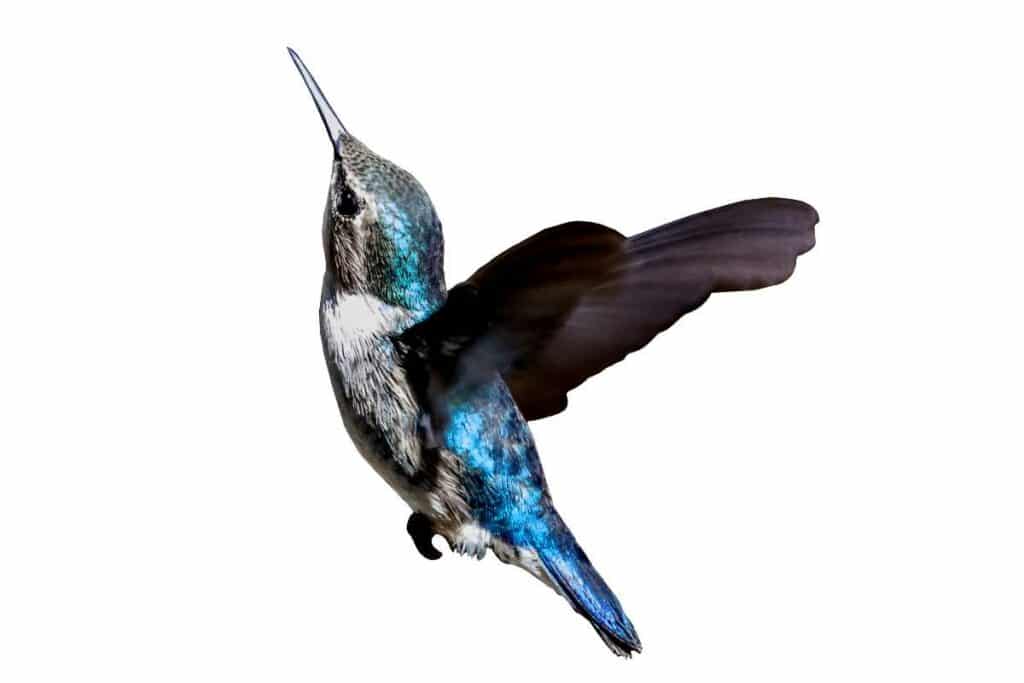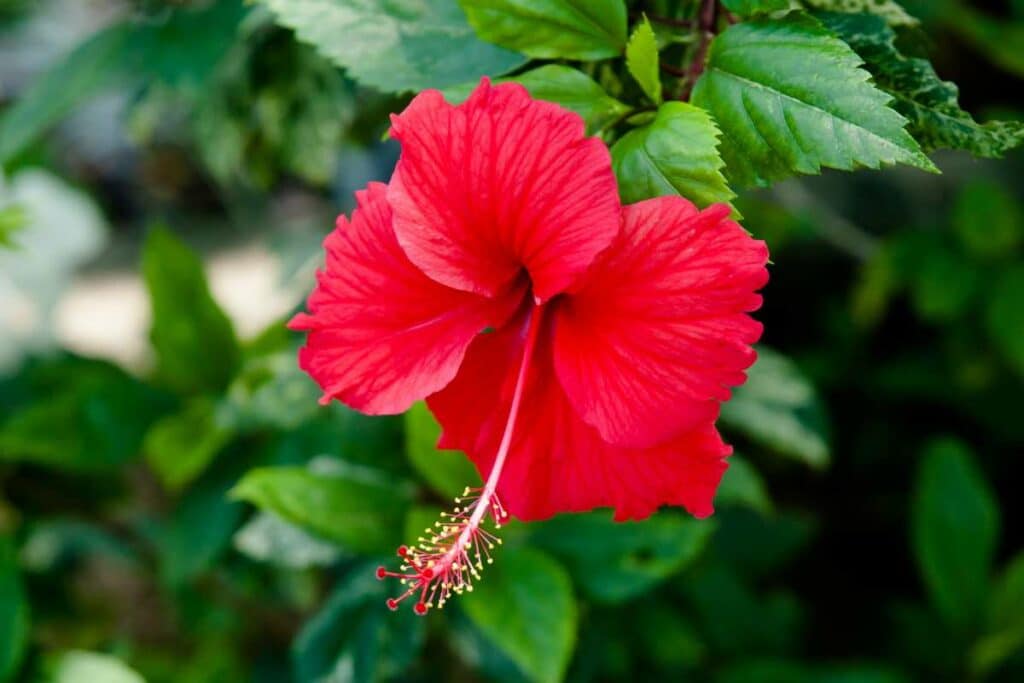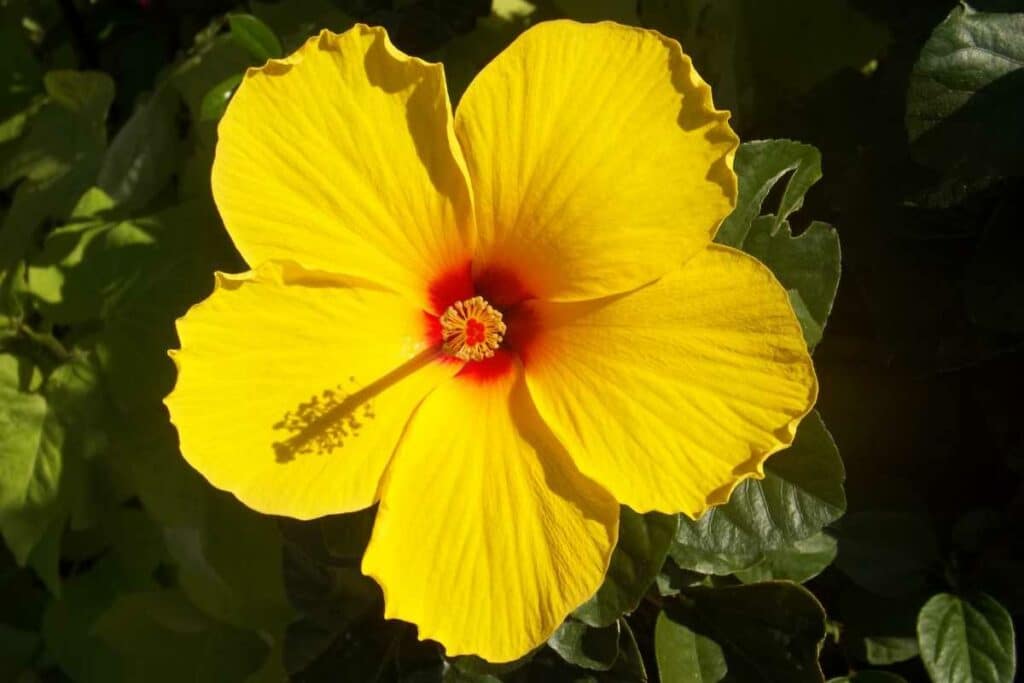If you’re a fan of hummingbirds and are looking for ways to attract these fascinating feathered friends to your garden, you might be wondering if they like hibiscus flowers.
Well, the answer is yes!
Hummingbirds are particularly drawn to the vibrant colors and sweet nectar that hibiscus flowers offer, making these plants a popular choice for those looking to create a hummingbird-friendly garden environment.
One of the reasons hibiscus flowers are so attractive to hummingbirds is the rich nectar they produce. This provides a valuable energy source for these tiny birds, allowing them to maintain their incredibly high metabolism.
The large size and funnel-like shape of hibiscus flowers also make it easy for hummingbirds to access the nectar, using their long beaks and specialized tongues to effortlessly reach the sweet treat inside.

Hibiscus plants are also visually appealing, boasting impressive blooms in a variety of colors, which can grow up to six inches across at their largest (source).
With such striking features, it’s no wonder that these flowers act as a magnet for hummingbirds, who are naturally drawn to brightly colored blossoms.
By including hibiscus plants in your garden, you’re not only adding a touch of beauty to your outdoor space but also creating a paradise for these delightful little birds, who are sure to bring joy and excitement to your backyard.
Hummingbirds and Hibiscus Flowers
As an avid gardener and bird lover, you’re probably always looking for ways to attract more beautiful hummingbirds to your outdoor space.
One of the most effective methods is to include plants that hummingbirds love, like the vibrant and lush hibiscus flowers. These stunning plants are not only visually appealing, but they also provide a great source of nectar for hummingbirds, and as you will see, they are a perfect choice for your garden.
The nectar and sweet scent of hibiscus flowers are some of the main reasons why hummingbirds are so attracted to them.
The large, deep-toned blooms make it easy for these tiny birds to spot and access the nectar hidden within the flower. Additionally, the unique shape of hibiscus flowers creates a perfect platform for hummingbirds to perch on while they feed.

When considering what colors and types of hibiscus flowers to plant in your garden, it’s important to remember that hummingbirds are attracted to vibrant colors, such as red, orange, and pink.
This makes hibiscus an ideal option, as they come in a wide range of vivid hues, ensuring you will find a variety that suits both your taste and that of your feathered visitors.
Another aspect to consider is that hibiscus flowers are heat lovers, so they will thrive in sunny spots in your garden.
This is crucial, as hummingbirds tend to seek out warm, sunlit areas. According to Family Handyman, the ideal planting zones for hibiscus are between Zones 4 to 9. However, it’s always a good idea to check the specific growing requirements for the type of hibiscus you choose, to ensure the best results.
Along with incorporating hibiscus flowers, you may want to consider adding some other hummingbird-friendly elements to your outdoor space.
Combining hibiscus with other nectar-rich flowers and plants is a great way to create an attractive environment for hummingbirds. Some other popular flowers that attract these beautiful birds include:
- Salvia
- Trumpet vine
- Beebalm
- Zinnias
- Penstemon
Remember, planting an array of flowers that bloom at different times will ensure you have a continual supply of nectar and activity in your garden, meaning more opportunities to admire hummingbirds throughout the seasons.
Another aspect to think about when attracting hummingbirds is providing a fresh water source, such as a birdbath or a small fountain. This will allow hummingbirds to drink and bathe as needed, making your garden even more appealing to them.
It’s also important to avoid using pesticides in your garden. Many hummingbirds feed on insects to supplement their nectar diet, so a pesticide-free environment will provide them with a safe and healthy source of food.
Furthermore, reducing pesticide usage will protect the hibiscus flowers themselves, ensuring that they remain a thriving and attractive feature in your garden.
In summary, planting hibiscus flowers in your garden will not only add a pop of color and tropical flair, but it will also make your space more inviting and habitable to hummingbirds.
By choosing the right variety and growing conditions, along with providing a safe and nourishing environment, you’ll be sure to enjoy the sights and sounds of these enchanting birds as they visit your hibiscus flowers.
Why Hummingbirds Are Attracted to Hibiscus Flowers
In this section, we will explore the reasons why hummingbirds are attracted to hibiscus flowers. We will discuss their color preference, flower shape, and nectar content.
Understanding these factors can help you appreciate the relationship between these fascinating birds and the beautiful hibiscus plants in your garden.
Color Preference
Hummingbirds are naturally drawn to brightly colored flowers, which serve as an important visual cue for them.
Hibiscus flowers come in various striking colors, such as red, orange, and pink, that easily catch the attention of hummingbirds.
According to Plantgardener, the deep-toned blooms of hibiscus make it a favorite of hummingbirds. They use their exceptional color vision to seek out these vibrant flowers as potential sources of nectar.

Flower Shape
Another reason why hummingbirds are attracted to hibiscus flowers is their shape. Hibiscus flowers have a unique structure that makes it easier for these tiny birds to access their nectar.
Hibiscus flowers are shaped to the hummingbird’s benefit. With their long and tubular-shaped blooms, hibiscus flowers allow hummingbirds to suck the nectar found deep within the plant.
Their specially adapted long beaks make it easy for hummingbirds to reach the nectar tucked deep within the flower’s stamen.
This efficient design helps ensure that hummingbirds can quickly and effectively feed on the sweet nectar hidden within hibiscus flowers.
Nectar Content
Hibiscus flowers are not only visually appealing and well-shaped for hummingbirds, but they also provide a rich source of nectar.
The nectar content of a flower plays a significant role in attracting hummingbirds, as they require a high-calorie diet to sustain their energetic lifestyle.
The hibiscus plant is known for its high nectar content, making it a sought-after food source for these birds. Hibiscus flowers produce nectar throughout the year, ensuring that hummingbirds have a consistent supply of this energy-rich food.
In conclusion, hummingbirds are attracted to hibiscus flowers for various reasons. Their vibrant colors, unique shape, and rich nectar content make hibiscus an ideal food source for these energetic birds.
The relationship between hummingbirds and hibiscus plants showcases the intricate and beautifully balanced connection between floral design and the needs of the creatures that rely on them for survival.
Planting Hibiscus for Hummingbirds
To make the most of their hummingbird-attracting potential, it’s essential to plant hibiscus in the right location and provide them with the appropriate conditions for growth.
Choosing the Right Location
Selecting a suitable location for your hibiscus plants is key to ensuring they thrive and attract hummingbirds. You should take the following factors into account when choosing a spot for your hibiscus:
- Light: Hibiscus plants require full sun to partial shade for optimal growth. Make sure the area you choose receives at least 6 hours of sunlight per day – this exposure will promote a higher production of flowers, which in turn will attract more hummingbirds.
- Soil: The soil should be well-draining and slightly acidic, with a pH between 6.0 and 6.5. To improve drainage, you can add organic matter or use raised beds to plant your hibiscus.
- Space: Hibiscus plants can grow quite large, and they need enough room to spread out. Plant them at least 4 feet apart from one another to give them ample space to grow without competing for resources.
- Protection: Although hibiscus flowers are beloved by hummingbirds, they can also be appealing to pests. To protect your plants from unwanted visitors, consider planting them near other flowering shrubs that can deter pests, such as lavender or marigolds.
Providing Conditions for Growth
Once you’ve chosen the perfect location for your hibiscus plants, it’s important to provide them with the appropriate conditions for growth. Keep these factors in mind as you care for your plants:
- Water: Hibiscus plants prefer consistently moist soil, so water them regularly, especially during dry spells. Be careful not to overwater, as this can lead to root rot. Check the soil moisture before watering – if it feels dry several inches below the surface, it’s time to water.
- Fertilizer: To support healthy growth, use a balanced fertilizer (with equal amounts of nitrogen, phosphorus, and potassium) during the growing season. Alternatively, you can opt for a slow-release fertilizer to provide your plants with the nutrients they need throughout the season. Be sure to follow the manufacturer’s instructions to avoid over-fertilizing, which can harm your plants.
- Pruning: Prune your hibiscus plants regularly to keep them healthy and looking their best. Remove dead, damaged, or crowded branches, and trim them back in late winter or early spring to encourage new growth and more flowers.
- Mulching: Apply a layer of organic mulch, such as bark chips, straw, or leaves, around the base of your hibiscus plants. This helps to retain moisture, control weeds, and regulate soil temperature. Be sure not to pile mulch against the stem of your plants, as this can lead to disease and rot.
By planting hibiscus in the right location and providing the necessary conditions for growth, you’ll create a beautiful garden space that’s sure to attract hummingbirds. Keep an eye out for these delightful visitors, and enjoy the vibrant colors and sweet nectar of your hibiscus flowers.
Additional Tips for Attracting Hummingbirds
Offering a Variety of Flowers
Aside from hibiscus flowers, which hummingbirds are attracted to, it’s essential to provide various blooms in your garden to appeal to these delightful birds. A diverse selection of plants not only offers a rich food source for hummingbirds but also adds visual interest to your space.
Here are some flowers that you can add alongside hibiscus:
- Coral Bells (Heuchera, Zones 3 to 9)
- Salvia (Salvia, Zones 3 to 10)
- Trumpet Vine (Campsis radicans, Zones 4 to 9)
- Columbine (Aquilegia, Zones 3 to 9)
- Lupine (Lupinus, Zones 4 to 8)
- Hosta (Hosta, Zones 3 to 8)
Hummingbirds are particularly attracted to red flowers, so try to include as many red blooms as possible in your garden to make it more appealing.
Keeping Feeders Clean
While offering a variety of flowers is essential, hummingbirds also appreciate clean and well-maintained feeders.
Regular cleaning of your hummingbird feeders helps prevent the spread of disease and ensures the nectar remains fresh and appealing. Here are some tips to keep your feeders clean and inviting:
- Empty and clean your feeders every few days, or more frequently in hot weather.
- Use a solution of warm water with a small amount of vinegar or unscented soap to clean the feeder. Rinse thoroughly to remove any residue.
- Use a bottle brush or similar tool to clean hard-to-reach areas in the feeder.
- Avoid using harsh chemicals that might be harmful to hummingbirds.
- Before refilling the feeder, make sure it is completely dry to prevent mold growth.
By keeping your feeders clean and well-maintained, you’ll encourage hummingbirds to visit your garden and help them stay healthy.
Providing Water Sources
In addition to food sources like hibiscus flowers and nectar from feeders, hummingbirds appreciate water sources to bathe and drink.
Providing a water feature in your garden can attract more hummingbirds and enhance the overall beauty of your space.
Consider these water features to attract and accommodate hummingbirds:
- Birdbath: Choose a shallow birdbath with a textured surface that allows hummingbirds to grip while bathing. Ensure the water is no deeper than an inch or two since hummingbirds prefer shallow water.
- Mister: Hummingbirds enjoy flying through and bathing in misters or fine water spray. Set up a mister near your flowers or attach one to your birdbath to create an appealing oasis for hummingbirds.
- Fountain: A small, low fountain with multiple levels and dripping or splashing water can offer a place for hummingbirds to bathe and drink. Look for a design with shallow pools and a gentle water flow.
- Dripper: A simple dripping device that drips water into a birdbath or small basin can be appealing to hummingbirds. You can find commercially available drippers or create one yourself with a container and a slow-dripping hose.
Having these water sources in your garden will increase your chances of attracting hummingbirds and help them stay clean and hydrated.
By combining hibiscus flowers, various nectar-rich plants, clean feeders, and water features, you can create a hummingbird haven that both you and the birds will enjoy.
Round Up – Do Hummingbirds Like Hibiscus Flowers
By following these guidelines, you’ll create an inviting environment for hummingbirds in your garden. The stunning visual appeal of hibiscus flowers, combined with the various benefits for both hummingbirds and gardeners, make them an excellent addition to any outdoor space.
Planting hibiscus flowers in your garden is not only a fantastic way to attract these beautiful birds but also to add a touch of drama and intrigue to your blooming yard.


